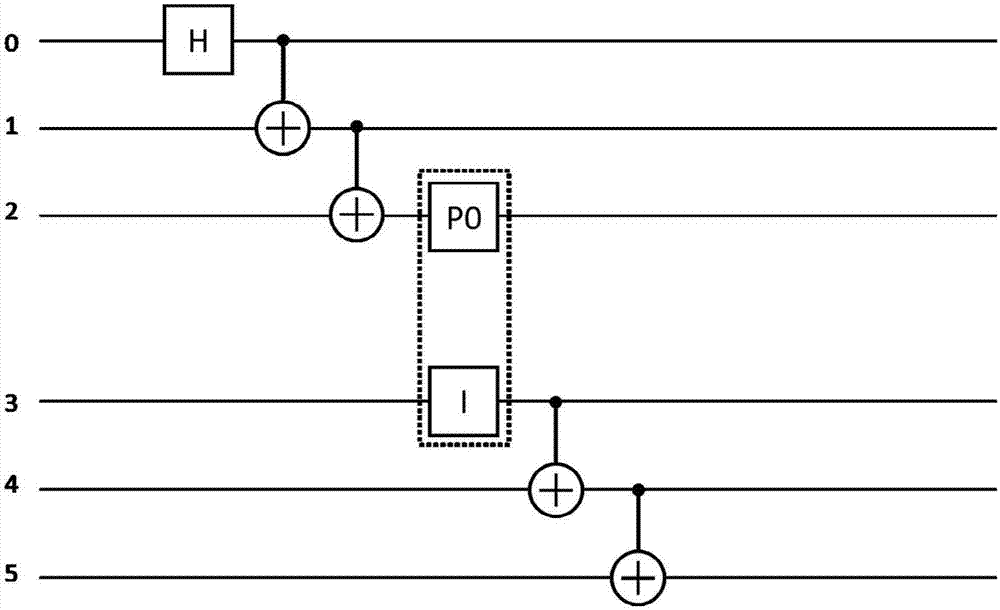Method for optimizing quantum circuit simulation
A circuit simulation and sub-circuit technology, applied in the field of quantum computing, can solve problems such as large storage space requirements, inability to calculate calculation time, and inappropriate simulation of quantum circuits, so as to achieve the effect of reducing storage space, calculation amount and storage space
- Summary
- Abstract
- Description
- Claims
- Application Information
AI Technical Summary
Problems solved by technology
Method used
Image
Examples
Embodiment 1
[0081] The quantum circuit shown in Figure 1(a) is simulated. In the dotted box is the CNOT gate to be transformed.
[0082] This circuit contains a total of 6 qubits and 6 quantum logic gates. Using the traditional method, the amount of computation and storage space required are
[0083] Cost(Legacy)=6*2 6 =384
[0084] Space (Legacy) = 2 6 =64
[0085] The following uses this scheme to simulate the circuit.
[0086] Execute step 1, and the input is the line to be simulated.
[0087] Execute step 2, set the threshold value to 3 bits, and the setting of the threshold value here is artificially controlled for the convenience of expressing the method. Because the circuit contains 6 qubits in total, and there is no two-quantum logic gate connection between any no more than 3 qubits and other qubits, go to step 3.
[0088] Execute step 3 to convert the circuit, and the target of the conversion is the logic gate (control NOT gate CNOT) inside the dotted box as shown in the ...
Embodiment 2
[0099] As shown in the quantum circuit simulation in Fig. 3(a), in the dotted box are two CZ gates to be converted in the following implementation process. This circuit contains a total of 8 qubits and 23 quantum logic gates. Using the traditional method, the amount of computation and storage space required are
[0100] Cost(Legacy)=14*2 8 =3854
[0101] Space (Legacy) = 2 8 =256
[0102] The following uses this scheme to simulate the circuit.
[0103]Execute step 1, and the input is the line to be simulated.
[0104] Execute step 2, set the threshold value to 4 bits, the setting of the threshold value here is artificially controlled, and the purpose is to express the method conveniently. Because the circuit contains 8 qubits in total, and there is no independent sub-circuit with qubits less than or equal to 4, go to step 3.
[0105] Execute step 3 to transform the circuit. The target of the transformation is the logic gate (control gate Z, CZ) inside the two dashed box...
Embodiment 3
[0119] The quantum circuit simulation shown in Figure 5(a) contains 6 qubits and 10 quantum logic gates in total. Using the traditional method, the amount of computation and storage space required are
[0120] Cost(Legacy)=10*2 6 =640
[0121] Space (Legacy) = 2 6 =64
[0122] The following uses this scheme to simulate the circuit.
[0123] Execute step 1, and the input is the line to be simulated.
[0124] Execute step 2, set the threshold value to 3 bits, and the setting of the threshold value here is artificially controlled for the convenience of expressing the method. Because the circuit contains 6 qubits in total, and there is no two-quantum logic gate connection between any no more than 3 qubits and other qubits, go to step 3.
[0125] Execute step 3, transform the circuit, and the target of the transformation is the TOFFOLI gate in the dotted box as shown in the figure (that is, the N=3 quantum controlled NOT gate). According to Theorem 2, the 3-bit quantum contr...
PUM
 Login to View More
Login to View More Abstract
Description
Claims
Application Information
 Login to View More
Login to View More - R&D
- Intellectual Property
- Life Sciences
- Materials
- Tech Scout
- Unparalleled Data Quality
- Higher Quality Content
- 60% Fewer Hallucinations
Browse by: Latest US Patents, China's latest patents, Technical Efficacy Thesaurus, Application Domain, Technology Topic, Popular Technical Reports.
© 2025 PatSnap. All rights reserved.Legal|Privacy policy|Modern Slavery Act Transparency Statement|Sitemap|About US| Contact US: help@patsnap.com



